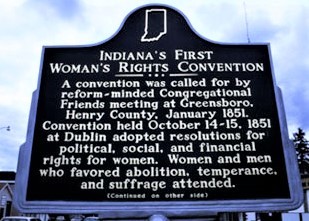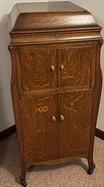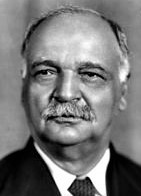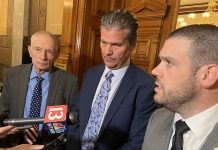
1851   Congregational Friends held a convention in Dublin, Indiana, in Wayne County, at which they adopted resolutions for political, social, and financial rights for women. Men and women in attendance favored abolition, temperance, and women’s suffrage. The next year, the convention created the Indiana Women’s Rights Association to consolidate efforts in pursuit of their various causes. Pictured: The Indiana Historic Marker in Dublin.Â
|

1920   The popularity of the phonograph was proven at the English Opera House in Indianapolis.  A large crowd of Victor record fans came to see and hear in person many of the entertainers they had been listening to on their Victrola “talking machines” at home. The recording stars on stage included John McCormack, Monroe Silver, Henry Burr, Albert Campbell, and Frank Banta. Pictured: A 1920’s style Victrola. Â
|
 1930   United States Vice President Charles Curtis was met by enthusiastic crowds as he visited seven Indiana cities all in the same day. Starting from Indianapolis, he traveled to Franklin, where he spoke at the Artcraft Theater. Moving on, he made speeches in Edinburgh, Columbus, Crothersville, Austin, and Scottsburg. At all stops, he encouraged Hoosiers to cooperate with President Herbert Hoover in his efforts in dealing with the nation’s economic problems. 1930   United States Vice President Charles Curtis was met by enthusiastic crowds as he visited seven Indiana cities all in the same day. Starting from Indianapolis, he traveled to Franklin, where he spoke at the Artcraft Theater. Moving on, he made speeches in Edinburgh, Columbus, Crothersville, Austin, and Scottsburg. At all stops, he encouraged Hoosiers to cooperate with President Herbert Hoover in his efforts in dealing with the nation’s economic problems. |
 1957   Parke County hosted its first Covered Bridge Festival. The event became an annual fall celebration which draws thousands of visitors each year. The festival showcases the county’s 31 historic covered bridges and features arts and crafts and a variety of delicious food. This year’s event runs from October 8 through October 17. 1957   Parke County hosted its first Covered Bridge Festival. The event became an annual fall celebration which draws thousands of visitors each year. The festival showcases the county’s 31 historic covered bridges and features arts and crafts and a variety of delicious food. This year’s event runs from October 8 through October 17. |
 1971   Rushville banker and attorney Philip H. Willkie spoke before the State Medical Association about the severe shortage of doctors in Indiana. He represented a coalition of church, farm, and civil rights groups which supported a new law proposing to erase the double standard applied to foreign doctors wishing to practice in Indiana. Willkie said he advocated reforms “in the way America selects, educates, and utilizes it physicians.” 1971   Rushville banker and attorney Philip H. Willkie spoke before the State Medical Association about the severe shortage of doctors in Indiana. He represented a coalition of church, farm, and civil rights groups which supported a new law proposing to erase the double standard applied to foreign doctors wishing to practice in Indiana. Willkie said he advocated reforms “in the way America selects, educates, and utilizes it physicians.” |
 2016   The Indiana Bicentennial Torch finished its journey through the state as it came to the “Hoosier Homecoming Day” celebration at the Statehouse. It had been carried by hundreds of Hoosiers through all 92 counties. Ceremonies at the Statehouse were held in the new Bicentennial Plaza as thousands came to celebrate the state’s 200th birthday. Governor Mike Pence was on hand, as well as enactors for Territorial Governor William Henry Harrison and former Governors Jonathan Jennings and William Hendrix. 2016   The Indiana Bicentennial Torch finished its journey through the state as it came to the “Hoosier Homecoming Day” celebration at the Statehouse. It had been carried by hundreds of Hoosiers through all 92 counties. Ceremonies at the Statehouse were held in the new Bicentennial Plaza as thousands came to celebrate the state’s 200th birthday. Governor Mike Pence was on hand, as well as enactors for Territorial Governor William Henry Harrison and former Governors Jonathan Jennings and William Hendrix. |
Photos: Former First Lady Judy O’Bannon started the torch on its journey from the old state capital of Corydon. After traveling through all 92 counties, the torch was brought to the Statehouse in Indianapolis by race driver Sarah Fisher.
Follow this link to subscribe to Hoosier History Highlights and to view archived editions
Follow us on Instagram: @instatehousetouroffice
|





 1930   United States Vice President Charles Curtis was met by enthusiastic crowds as he visited seven Indiana cities all in the same day. Starting from Indianapolis, he traveled to Franklin, where he spoke at the Artcraft Theater. Moving on, he made speeches in Edinburgh, Columbus, Crothersville, Austin, and Scottsburg. At all stops, he encouraged Hoosiers to cooperate with President Herbert Hoover in his efforts in dealing with the nation’s economic problems.
1930   United States Vice President Charles Curtis was met by enthusiastic crowds as he visited seven Indiana cities all in the same day. Starting from Indianapolis, he traveled to Franklin, where he spoke at the Artcraft Theater. Moving on, he made speeches in Edinburgh, Columbus, Crothersville, Austin, and Scottsburg. At all stops, he encouraged Hoosiers to cooperate with President Herbert Hoover in his efforts in dealing with the nation’s economic problems. 1957   Parke County hosted its first Covered Bridge Festival. The event became an annual fall celebration which draws thousands of visitors each year. The festival showcases the county’s 31 historic covered bridges and features arts and crafts and a variety of delicious food. This year’s event runs from October 8 through October 17.
1957   Parke County hosted its first Covered Bridge Festival. The event became an annual fall celebration which draws thousands of visitors each year. The festival showcases the county’s 31 historic covered bridges and features arts and crafts and a variety of delicious food. This year’s event runs from October 8 through October 17. 1971   Rushville banker and attorney Philip H. Willkie spoke before the State Medical Association about the severe shortage of doctors in Indiana. He represented a coalition of church, farm, and civil rights groups which supported a new law proposing to erase the double standard applied to foreign doctors wishing to practice in Indiana. Willkie said he advocated reforms “in the way America selects, educates, and utilizes it physicians.”
1971   Rushville banker and attorney Philip H. Willkie spoke before the State Medical Association about the severe shortage of doctors in Indiana. He represented a coalition of church, farm, and civil rights groups which supported a new law proposing to erase the double standard applied to foreign doctors wishing to practice in Indiana. Willkie said he advocated reforms “in the way America selects, educates, and utilizes it physicians.” 2016   The Indiana Bicentennial Torch finished its journey through the state as it came to the “Hoosier Homecoming Day” celebration at the Statehouse. It had been carried by hundreds of Hoosiers through all 92 counties. Ceremonies at the Statehouse were held in the new Bicentennial Plaza as thousands came to celebrate the state’s 200th birthday. Governor Mike Pence was on hand, as well as enactors for Territorial Governor William Henry Harrison and former Governors Jonathan Jennings and William Hendrix.
2016   The Indiana Bicentennial Torch finished its journey through the state as it came to the “Hoosier Homecoming Day” celebration at the Statehouse. It had been carried by hundreds of Hoosiers through all 92 counties. Ceremonies at the Statehouse were held in the new Bicentennial Plaza as thousands came to celebrate the state’s 200th birthday. Governor Mike Pence was on hand, as well as enactors for Territorial Governor William Henry Harrison and former Governors Jonathan Jennings and William Hendrix.




